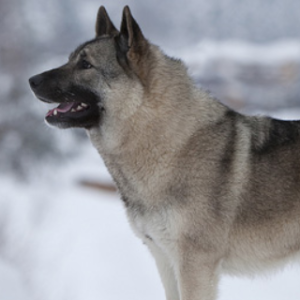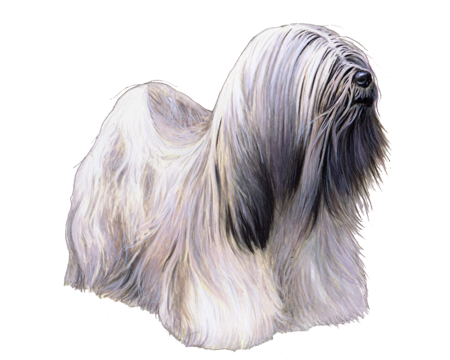
Norwegian Elkhound
The Norwegian Elkhound is outgoing and dependable. Their eagerness to please, combined with their sensitive, trusting natures, helped this hardy breed evolve from a reliable working dog into a popular pet.
Interested in discovering if your dog is a Norwegian Elkhound?
Check out Wisdom Panel's DNA tests.

Norwegian Elkhound Traits
General Appearance
The Norwegian Elkhound is a hardy hunting dog of medium size and substance. The breed has a keen, alert expression and the courage, stamina, and agility to track big game across uneven terrain.
Coat and Colouring
Norwegian Elkhounds are a double-coated breed with dense, woolly undercoats, and thick, weather-resistant overcoats. The hair on their heads, ears, and front of their legs is short and even. Longer hair covers the backs of their necks, buttocks, and undersides of their tails.
These dogs are a gray color, with shading created by black tips on individual hairs. The length of the black tips and the quantity of guard hairs determines their coat's overall shading—but they are darkest on the saddle and lighter on the chest and manes. Their undercoats and hair on their legs, stomachs, buttocks, and part of their tails are clear and light silver.
Distinctive Physical Traits
Norwegian Elkhounds are medium-sized dogs with straight backs, muscular necks, and broad, wedge-shaped heads. They carry their high set, tightly curled tails over the centerline of their backs. Dark brown, medium-sized, oval eyes give the breed a keen, alert expression. Norwegian Elkhounds also have high set, erect ears that go back when they're relaxed or showing affection.
Norwegian Elkhound Temperament
It's no surprise that the Norwegian Elkhound has been a devoted companion for centuries. The breed is bold, energetic, and independent and also affectionate, dependable, and friendly—the perfect breed for work and play.
Norwegian Elkhounds can be reserved with strangers but are quick to warm up. These dogs are sensitive souls that want affection, companionship, and devotion from their owners—but they also have an independent streak. They'll happily hang out on their own while their humans are at work.
As long as this active breed gets sufficient exercise, it's a calm, respectful breed that would adapt to living in an apartment.


Norwegian Elkhound History
The Norwegian Elkhound has held many jobs in its long history—from herder, hauler, and hunter to guardian and watchdog. Their adaptable natures and strong work ethics are a few of the reasons the Norwegian Elkhound has been a popular breed since the 1100s.
Considered one of the oldest breeds in England, the Norwegian Elkhound has a strong presence in Norse history and mythology. Examples include a dog thought to be a Norwegian Elkhound buried alongside its Viking master, a Norwegian Elkhound skeleton found in a cave dating back to 4,000 B.C., and a Norwegian Elkhound dubbed "king of the land" of Throndhjem.
These ancient dogs earned their names for their primary job hunting elk. The Norwegian Elkhound tracked the massive animals for miles and held them until the hunters arrived.
Norwegian Elkhound Care
Nutrition
Feed Norwegian Elkhounds a high-quality dog food that's appropriate for their age and activity level. These dogs have hearty appetites and are skilled at convincing their humans to hand over treats. Portion out their food in a measuring cup and limit treats to no more than 10% of their daily calories to avoid overfeeding.
Grooming
Norwegian Elkhounds require daily brushing to keep their thick, double coats looking their best. A slicker brush is the best tool for the job. Brush in the opposite direction of hair growth to remove dead hair and help control shedding.
Norwegian Elkhounds "blow their coats" twice per year. Grooming needs to be stepped up during these periods to manage their undercoats. Bathing them during these seasonal shedding periods will also help. To round out the grooming routine, keep their nails trimmed and ears cleaned.
Norwegian Elkhounds also require regular dental care that includes at-home teeth brushing and annual professional dental cleanings. Start a dental care program early and maintain it throughout their lives.
Exercise
Norwegian Elkhounds were bred to track elk through the woods. In the absence of extensive hunting trips, the breed requires other fast-paced activities to meet their exercise needs. Long walks (or runs) or off-leash play are excellent ways to help Norwegian Elkhounds burn off some energy. The breed also loves swimming and excels at activities such as agility and herding, which take advantage of their speed, stamina, and intelligence.
Do not let Norwegian Elkhounds off-leash in unfenced areas. These independent dogs are prone to following their noses and might ignore commands to come back.
Training
Despite being intelligent and quick to learn new things, Norwegian Elkhounds can get bored with repetitive tasks during obedience training. Maintain their interest by keeping training sessions short and choosing fast-paced and fun activities.
Norwegian Elkhounds are sensitive. Instead of harsh criticism or punishments, prioritize positive training methods. This breed is food motivated and responds well to reward-based training using their favorite treats.

Norwegian Elkhound Genetic Health Conditions
-
Chondrodysplasia (Discovered in Norwegian Elkhound and Karelian Bear Dog)
Chondrodysplasia is a skeletal disorder that leads to the development of shorter than normal legs.
-
Early Retinal Degeneration (Discovered in the Norwegian Elkhound)
Early retinal degeneration (ERD) is an eye disorder characterized by abnormal development followed by degeneration of photoreceptors in the eye. The disorder causes early onset blindness in Norwegian Elkhounds.
Knowing if your Norwegian Elkhound is a carrier or at-risk for these conditions can help you and your veterinarian plan for your pup's lifelong care. With Wisdom Panel™ Premium, you can get results for over 200 genetic health tests.
Breed Group
Companion
This group consists of dogs typically bred for the specific purpose of human companionship, and many are popular pets because of their gentle nature. They became more common as the concept and luxury of dogs as pets prevailed.
Resources
https://www.akc.org/dog-breeds/norwegian-elkhound/
http://images.akc.org/pdf/breeds/standards/NorwegianElkhound.pdf
Reviewed 26 July 2020 by Annette Louviere, DVM



























_Color.png)




















